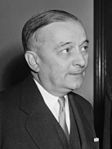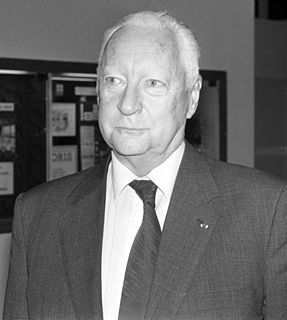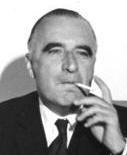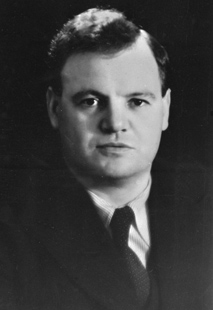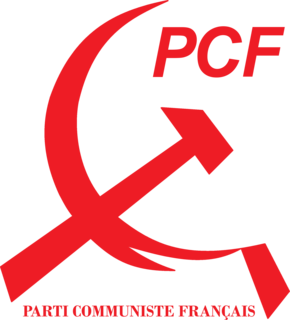| |||||||||||||||||||||||||||||||||||||||||||||||||||||||||||||||||||||||||||||
All 625 seats to the French National Assembly 313 seats were needed for a majority | |||||||||||||||||||||||||||||||||||||||||||||||||||||||||||||||||||||||||||||
| |||||||||||||||||||||||||||||||||||||||||||||||||||||||||||||||||||||||||||||
| |||||||||||||||||||||||||||||||||||||||||||||||||||||||||||||||||||||||||||||
Legislative elections were held in France on 17 June 1951 to elect the second National Assembly of the Fourth Republic.

The French Fourth Republic was the republican government of France between 1946 and 1958, governed by the fourth republican constitution. It was in many ways a revival of the Third Republic that was in place from 1870 during the Franco-Prussian War to 1940 during World War II, and suffered many of the same problems. France adopted the constitution of the Fourth Republic on 13 October 1946.
Contents
After the Second World War, the three parties which took a major part in the French Resistance to the German occupation dominated the political scene and government: the French Communist Party (PCF), the French Section of the Workers' International (SFIO, socialist party) and the Christian democratic Popular Republican Movement (MRP). The forces associated with the Third Republic and the 1940 disaster (the Radical Party and the classical Right) were considered as archaic and were the losers of the post-war elections.

The French Resistance was the collection of French movements that fought against the Nazi German occupation of France and the collaborationist Vichy régime during the Second World War. Resistance cells were small groups of armed men and women, who, in addition to their guerrilla warfare activities, were also publishers of underground newspapers, providers of first-hand intelligence information, and maintainers of escape networks that helped Allied soldiers and airmen trapped behind enemy lines. The men and women of the Resistance came from all economic levels and political leanings of French society, including émigrés, academics, students, aristocrats, conservative Roman Catholics, and also citizens from the ranks of liberals, anarchists and communists.
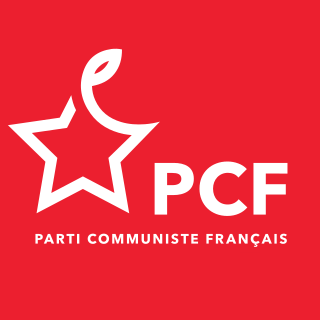
The French Communist Party is a communist party in France.
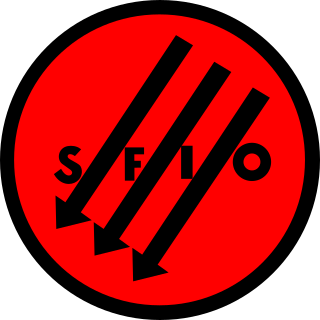
The French Section of the Workers' International was a French socialist party founded in 1905 and replaced in 1969 by the current Socialist Party (PS). It was created during the 1905 Globe Congress in Paris as a merger between the French Socialist Party and the Socialist Party of France in order to create the French section of the Second International, designated as the party of the workers' movement.
Nevertheless, after the proclamation of the Fourth Republic, the 1947 strikes and the beginning of the Cold War, the Three-parties alliance split. In spring 1947, the Communist ministers were dismissed. At the same time, Charles de Gaulle, symbol of the Resistance, founded his Rally of the French People (RPF) which campaigned for constitutional reform and criticized the "parties' regime" as a rebirth of the defunct Third Republic.
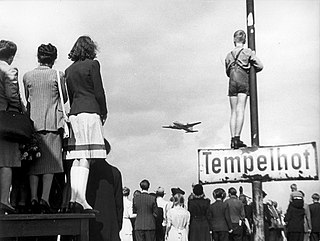
The Cold War was a period of geopolitical tension between the Soviet Union with its satellite states, and the United States with its allies after World War II. A common historiography of the conflict begins between 1946, the year U.S. diplomat George F. Kennan's "Long Telegram" from Moscow cemented a U.S. foreign policy of containment of Soviet expansionism threatening strategically vital regions, and the Truman Doctrine of 1947, and ending between the Revolutions of 1989 and the 1991 collapse of the USSR, which ended communism in Eastern Europe. The term "cold" is used because there was no large-scale fighting directly between the two sides, but they each supported major regional conflicts known as proxy wars. The conflict split the temporary wartime alliance against Nazi Germany, leaving the USSR and the US as two superpowers with profound economic and political differences.

Charles André Joseph Marie de Gaulle was a French army officer and statesman who led the French Resistance against Nazi Germany in World War II and chaired the Provisional Government of the French Republic from 1944 to 1946 in order to establish democracy in France. In 1958, he came out of retirement when appointed President of the Council of Ministers by President René Coty. He was asked to rewrite the Constitution of France and founded the Fifth Republic after approval by referendum. He was elected President of France later that year, a position he was reelected to in 1965 and held until his resignation in 1969. He was the dominant figure of France during the Cold War era, and his memory continues to influence French politics.

The Rally of the French People was a French political party, led by Charles de Gaulle.
The Socialists and the Christian-Democrats allied with the Rally of the Republican Lefts (composed of the Radicals and the Democratic and Socialist Union of the Resistance, UDSR) and right-wing groupings to form the Third Force. This coalition defended the regime against the opposition of the Communists on the one hand, and the Gaullists on the other. But this diverse alliance did not lead to a stable executive power. Indeed, its components advocated opposing policies on the economy, the finances of the state, secularism ( laïcité ) and denominational schools. This discontent was beneficial to the Communists and the Gaullists.
The Democratic and Socialist Union of the Resistance was a French political party founded after the liberation of France from German occupation and mainly active during the Fourth Republic (1947–58). It was a loosely organised "cadre party" without mass membership. Its ideology was vague, including a broad diversity of different political convictions with descriptions ranging from left-wing via centrist to conservative. It was decidedly anti-communist and linked with the Paix et Liberté movement. The UDSR was a founding member of the Liberal International in 1947.
The Third Force was a French coalition during the Fourth Republic (1947–1958) which gathered the French Section of the Workers' International (SFIO) party, the centre-right Democratic and Socialist Union of the Resistance (UDSR), the Radicals, the Christian democrat Popular Republican Movement (MRP) and other centrist politicians, opposed both to the French Communist Party (PCF) and the Gaullist movement. The Third Force governed France from 1947 to 1951, succeeding the tripartisme alliance between the SFIO, the MRP and the PCF. The Third Force was also supported by the conservative National Centre of Independents and Peasants (CNIP), which succeeded in having its most popular figure, Antoine Pinay, named Prime Minister in 1952, a year after the dissolving of the Third Force coalition.

Laïcité, literally "secularity", is a French concept of secularism. It discourages religious involvement in government affairs, especially religious influence in the determination of state policies; it also forbids government involvement in religious affairs, and especially prohibits government influence in the determination of religion.
On March 1951, Henri Queuille (Radical Party), became head of the cabinet. His Vice-Prime Ministers were Georges Bidault (MRP), Guy Mollet (SFIO) and René Pleven (UDSR). In order to limit the number of seats won by the Communists and the Gaullists, an electoral reform was passed. The proportional representation system was conserved but if an alliance of parties obtained more of 50% of votes in a given constituency, it won all the seats. The promoters of the electoral reform knew the Communists and the Gaullists were so different from allie contrary to the parties of the Third Force. They hoped the alliance of the pro-government parties would reach the 50% threshold in a maximum of constituencies, whereas the PCF and the RPF would be eliminated of representation.
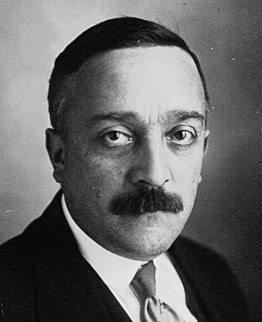
Henri Queuille was a French Radical politician prominent in the Third and Fourth Republics. After World War II, he served three times as Prime Minister.
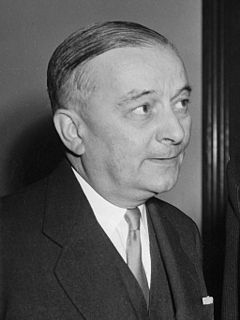
Georges-Augustin Bidault was a French politician. During World War II, he was active in the French Resistance. After the war, he served as foreign minister and prime minister on several occasions before he joined the Organisation armée secrète.
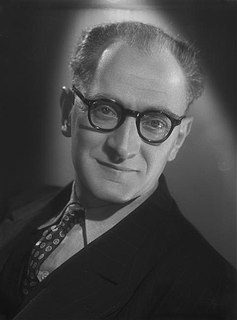
Guy Alcide Mollet was a French politician. He led the socialist French Section of the Workers' International (SFIO) from 1946 to 1969 and was the French Prime Minister from 1956 to 1957.
Whilst the PCF and the RPF were the two largest parties in terms of the popular vote, the Third Force remained the parliamentary majority. Due to the ballot system, the Communist Party, which won more votes than any other party, was only third in terms of the number of seats won. In the winning coalition, the SFIO and the MRP lost support whereas the Radicals and the classical Right made gains. However, due to continuing internal divisions (about the denominational schools, the budget and the colonial question) the problem of the stability of the executive was not resolved. On August 1951, René Pleven replaced Henri Queuille as Prime Minister and the Socialists left the cabinet.


